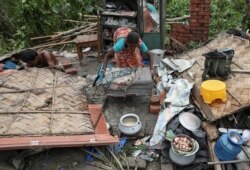A strong cyclone that struck parts of eastern India and Bangladesh earlier this week, leaving a trail of mass destruction and chaos, has caused $13 billion in damage to infrastructure and crops, Indian officials said Saturday.
In neighboring Bangladesh, government officials initially said Cyclone Amphan had caused $130 million in damage, but that the number could rise.
Amphan killed at least 102 people in the two countries, largely because of collapses of homes and electrocutions.
Officials said the death toll could have been higher if more than 3 million people had not been evacuated before Amphan made landfall.
Two West Bengal government officials told Reuters on Saturday that the cyclone had damaged homes, crops and other property owned by more than 13 million people.
Wreckage in Kolkata
The cyclone also left a trail of devastation through the state’s densely populated capital, Kolkata, with rain and strong winds uprooting trees and electric poles, disrupting power supply, damaging buildings and leaving homes waterlogged in low lying areas.
U.N. Secretary-General António Guterres said in statement Saturday that he was “saddened by the loss of lives and destruction” in the two countries and commended “the governments, first responders and communities for their pre-emptive work to make people safe ahead of the storm and to meet their immediate needs afterwards.”
Guterres also said the U.N. “stands ready to support these efforts.”
The storm struck while South Asia struggles with the coronavirus pandemic.
The U.N. children's fund (UNICEF) said earlier this week that the storm had put 19 million children at risk, not only from the direct effects of floods and wind damage but also from the potential spread of COVID-19 in crowded evacuation shelters.
Amphan caused additional misery for the hundreds of thousands of Rohingya refugees living in camps in Bangladesh and Myanmar, which have already reported a number of COVID-19 cases.
Little protection
U Khine Myo Aung, the manager of one camp in Kyauktaw Township in Myanmar’s Rakhine state, told VOA’s Burmese service earlier this week that the tents in which the refugees were living provided little protection from the storm.
The manager of another camp, Ko Shwe So, told VOA that children and the elderly were suffering most: “As camp manager, I would like to build proper accommodation for refugees, but no funds are available.”
Bangladesh has a history of being hit by cyclones, but Amphan ranks among the most powerful, said Save the Children in Bangladesh humanitarian director Mostak Hussain.
VOA Burmese service stringers Zaw Htet and Thet Naing and VOA U.N. Correspondent Margaret Besheer contributed to this report.









